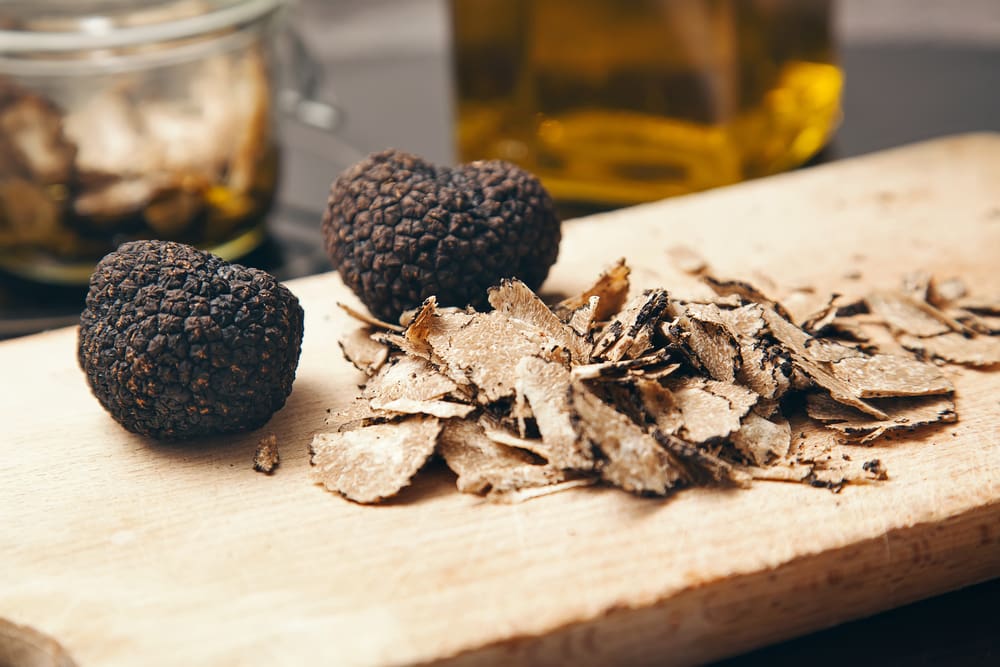If you pay attention to the food world at all, then you are definitely familiar with truffles. The divisive ingredient comes in several varieties and is coveted for its intense aroma when freshly shaven on a dish. When a plate with truffles heads into the dining room, it always turns heads because of how aromatic they are. But, beyond the love and admiration for the pungent fungus is a hefty price tag. Truffles will often be the most expensive item on a menu and it’s not uncommon to see a few grams of the stuff cost upwards of $80 to simply add to a pasta or meat. So, what’s the deal? Why are truffles so expensive?
Truffles Vs. Mushrooms
Before we get into the nitty gritty, one thing has to be made clear: truffles and mushrooms do come from the same family, but they are not the same thing.
Truffles grow underground, while mushrooms grow above ground. Additionally, no matter the type of truffle, they are found in the wild (there are some cultivated truffles now, but availability remains scarce). Like ramps (a wild leek seen often in the Springtime), truffles are mainly foraged in the wild; whereas mushrooms can be farmed or wild.
View this post on Instagram
Why Are Truffles So Expensive?
So, now the reason you’re here: why are truffles so damn expensive?
Because truffles cannot be farmed or planted at home, the availability is obviously much lower than something that is easily farmed. To add to this, truffles can only be harvested during certain points of the year. There are summer truffles, winter truffles and so on—each variety comes with a season.
Moreover, each variety comes with a different price tag. There have been strides made in the cultivation aspect of truffles—some ways to farm them have been discovered, but it remains scarce and expensive.
View this post on Instagram
Truffles require relationships with other plants in the wild to flourish—they tend to grow near specific types of tree roots and require this symbiotic relationship to grow. This pathogenic relationship is known as mycorrhizae.
To make growing conditions for truffles even more high maintenance, the fungi require cool winters, damp springs and hot summers—meaning that areas where they grow remain hyper-specific. Even with perfect conditions, truffles grow incredibly slow, often taking more than six years until ready to harvest. Once ready, the seasonal window remains small.
Why Do Dogs and Pigs Hunt Truffles?
Even if you know very little about truffles, you have probably heard about the dogs or pigs that are trained to hunt for them. As we know now, truffles grow underground and are incredibly aromatic. However, humans are unable to smell them while unharvested; but, many animals can. So, to efficiently forage for them, dogs or pigs are trained to lend a helping hand (paw? trotter?).
This method alleviates hours of what would essentially be blind digging. Imagine searching for metals on the beach without a metal detector? Relying on guesswork to dig? What a nightmare.
Different Types of Truffles
Truffles come in various species, sizes, flavors and price points. These are a few of the truffle varieties you might see on a menu throughout the year.
Périgord Truffle
Also called the Tuber Melanosporum, this black truffle is the sought after because of its intense smell and flavor. These truffles are found in the wild in Italy and France and often go for $100 an ounce. Périgords have begun being cultivated in different parts of the world, but it remains expensive and labor intensive.
White Alba
Also known as the Tuber Magnatum, this white truffle has a small harvest window (September to December) and is found primarily in Northern Italy. White truffles are coveted for their amazing aroma and ability to shine raw. The outside resembles a small potato with a tannish color. To many, Alba truffles are the most luxurious-tasting on the market.
View this post on Instagram
Summer Truffle
This reasonably-priced truffle is officially known as Tuber Aestivum. Unlike other truffles listed, the harvest period for the summer truffle is large—ranging from May to September (most truffle species are harvested in autumn and early winter). The aroma is much milder—with hints of sweet hazelnut—and the price is light compared to other varieties. If you have never tried truffles before and are weary of spending the money, maybe give summer truffles a shot first.
Bourgogne Truffle
Sometimes called the Champagne truffle or more formally, Tuber Uncinatum, this truffle is deep brown in color—teetering on pitch black. This truffle prefers the shade to flourish, and forests are often where you will find them the most. Bourgogne truffles can be found from the Mediterranean all the way into parts of Russia.
View this post on Instagram
Are Truffles Worth the Price?
I labeled truffles before as a “divisive ingredient” and that’s because they are. While many people adore the flavor of truffle, others feel they are not worth the price tag, while some even despise the fungus altogether. I myself do not particularly love truffle, but that’s just a preference. I totally understand the allure for them and the price tag that comes along with it, but it doesn’t mean I’m going out of my way to eat them.
Besides, when it comes to luxury ingredients, caviar is where it’s at.
About the Author/s
Peter Candia is the Food + Drink Editor at New Jersey Digest. A graduate of The Culinary Institute of America, Peter found a passion for writing midway through school and never looked back. He is a former line cook, server and bartender at top-rated restaurants in the tri-state area. In addition to food, Peter enjoys politics, music, sports and anything New Jersey.
